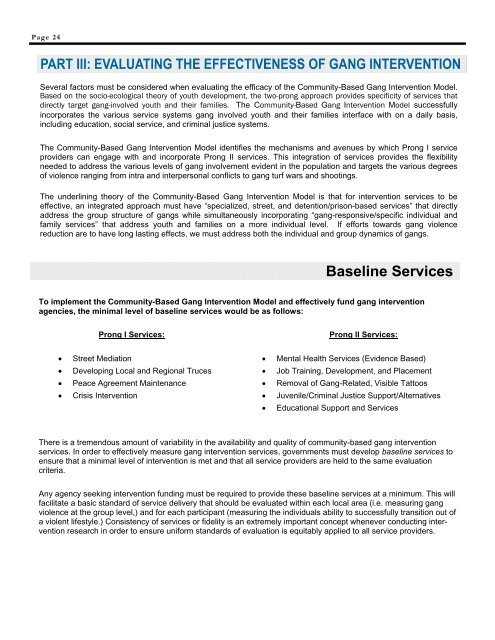Community-based gang intervention - Office of the City Attorney ...
Community-based gang intervention - Office of the City Attorney ...
Community-based gang intervention - Office of the City Attorney ...
You also want an ePaper? Increase the reach of your titles
YUMPU automatically turns print PDFs into web optimized ePapers that Google loves.
Page 24<br />
Several factors must be considered when evaluating <strong>the</strong> efficacy <strong>of</strong> <strong>the</strong> <strong>Community</strong>-Based Gang Intervention Model.<br />
Based on <strong>the</strong> socio-ecological <strong>the</strong>ory <strong>of</strong> youth development, <strong>the</strong> two-prong approach provides specificity <strong>of</strong> services that<br />
directly target <strong>gang</strong>-involved youth and <strong>the</strong>ir families. The <strong>Community</strong>-Based Gang Intervention Model successfully<br />
incorporates <strong>the</strong> various service systems <strong>gang</strong> involved youth and <strong>the</strong>ir families interface with on a daily basis,<br />
including education, social service, and criminal justice systems.<br />
The <strong>Community</strong>-Based Gang Intervention Model identifies <strong>the</strong> mechanisms and avenues by which Prong I service<br />
providers can engage with and incorporate Prong II services. This integration <strong>of</strong> services provides <strong>the</strong> flexibility<br />
needed to address <strong>the</strong> various levels <strong>of</strong> <strong>gang</strong> involvement evident in <strong>the</strong> population and targets <strong>the</strong> various degrees<br />
<strong>of</strong> violence ranging from intra and interpersonal conflicts to <strong>gang</strong> turf wars and shootings.<br />
The underlining <strong>the</strong>ory <strong>of</strong> <strong>the</strong> <strong>Community</strong>-Based Gang Intervention Model is that for <strong>intervention</strong> services to be<br />
effective, an integrated approach must have “specialized, street, and detention/prison-<strong>based</strong> services” that directly<br />
address <strong>the</strong> group structure <strong>of</strong> <strong>gang</strong>s while simultaneously incorporating “<strong>gang</strong>-responsive/specific individual and<br />
family services” that address youth and families on a more individual level. If efforts towards <strong>gang</strong> violence<br />
reduction are to have long lasting effects, we must address both <strong>the</strong> individual and group dynamics <strong>of</strong> <strong>gang</strong>s.<br />
To implement <strong>the</strong> <strong>Community</strong>-Based Gang Intervention Model and effectively fund <strong>gang</strong> <strong>intervention</strong><br />
agencies, <strong>the</strong> minimal level <strong>of</strong> baseline services would be as follows:<br />
Prong I Services:<br />
• Street Mediation<br />
• Developing Local and Regional Truces<br />
• Peace Agreement Maintenance<br />
• Crisis Intervention<br />
Prong II Services:<br />
• Mental Health Services (Evidence Based)<br />
• Job Training, Development, and Placement<br />
• Removal <strong>of</strong> Gang-Related, Visible Tattoos<br />
• Juvenile/Criminal Justice Support/Alternatives<br />
• Educational Support and Services<br />
There is a tremendous amount <strong>of</strong> variability in <strong>the</strong> availability and quality <strong>of</strong> community-<strong>based</strong> <strong>gang</strong> <strong>intervention</strong><br />
services. In order to effectively measure <strong>gang</strong> <strong>intervention</strong> services, governments must develop baseline services to<br />
ensure that a minimal level <strong>of</strong> <strong>intervention</strong> is met and that all service providers are held to <strong>the</strong> same evaluation<br />
criteria.<br />
Any agency seeking <strong>intervention</strong> funding must be required to provide <strong>the</strong>se baseline services at a minimum. This will<br />
facilitate a basic standard <strong>of</strong> service delivery that should be evaluated within each local area (i.e. measuring <strong>gang</strong><br />
violence at <strong>the</strong> group level,) and for each participant (measuring <strong>the</strong> individuals ability to successfully transition out <strong>of</strong><br />
a violent lifestyle.) Consistency <strong>of</strong> services or fidelity is an extremely important concept whenever conducting <strong>intervention</strong><br />
research in order to ensure uniform standards <strong>of</strong> evaluation is equitably applied to all service providers.


